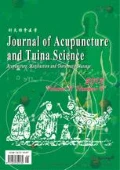Abstract
Objective
To observe the clinical efficacy of auricular point sticking combined with cupping in treating insomnia.
Methods
Sixty-four patients with chronic insomnia were randomly divided into two groups. Thirty-two patients in the treatment group were treated with auricular point sticking combined with cupping therapy; while thirty-two patients in the control group were treated by Diazepam. The Pittsburgh sleep quality index (PSQI) were observed before and after treatment, and the data were statistically analyzed to evaluate the clinical effect.
Results
After treatment, PSQI scores in both groups after treatment significantly decreased (P<0.05), and there was a significant difference between the two groups (P<0.05). In the improvement of daytime function, the treatment group was more efficient than the control group (P<0.05). The total effective rate of the treatment group was higher than that of the control group (P<0.05).
Conclusion
Auricular point sticking combined with cupping therapy for insomnia is more effective than oral Diazepam, and it has a better effect in improving the patient’s daytime function.
Similar content being viewed by others
References
Tian HJ, Huang LQ, Zhao ZX. Assessment and treatment of insomnia. Acad J Sec Mil Med Univ, 2006, 27(5): 538–540.
Roth T. New developments for treating sleep disorders. J Clin Psychiatry, 2001, 62(Suppl 10): 3–4.
Experts group of expert consensus for the definition, diagnosis and treatment of insomnia. Expert consensus for the definition, diagnosis and treatment of insomnia (draft). Zhonghua Shenjingke Zazhi, 2006, 39(2): 141–143.
Liu XC, Tang MQ, Hu L, Wang AZ, Xi HX, Zhao GF, Gao CN, Li WS. Reliability and validity of the Pittsburgh sleep quality index. Zhonghua Shenjingke Zazhi, 1996, 29(2): 103–107.
Ministry of Health of the People’s Republic of China. Guiding Principles for Clinical Study of New Chinese Medicines. Beijing: China Medico-Pharmaceutical Science & Technology Publishing House, 1993: 186–187.
Xu ZP, Chen WJ, Li HH, Li YH. Study and treatment of insomnia. Zhongguo Linchuang Kangfu, 2006, 10(22): 151–153.
Huang QF. Exploration of the clinical regularity of acupuncture and moxibustion treatment for insomnia. J Acupunct Tuina Sci, 2010, 8(1): 12–16.
Pei Y, Wang WM. Observations on the efficacy of acupuncture plus auricular point magnetic bead plaster therapy in treating insomnia. Shanghai Zhenjiu Zazhi, 2009, 28(11): 629–631.
Yuan X. Clinical observation on acupuncture plus auricular point sticking in treating insomnia. J Acupunct Tuina Sci, 2010, 8(5): 302–303.
Wei CJ. Concise Science of Auricular Acupuncture. Hefei: Anhui Science and Technology Publishing House, 1987: 5.
Shi YQ. Textbook of Clinical Neurology. 2nd Edition. Shanghai: Shanghai Science and Technology Publishing House, 1994: 1124.
Wang GL. Clinical observations on auricular point plaster therapy for insomnia. Shanghai Zhenjiu Zazhi, 2012, 31(10): 725–726.
Shao M, Wen LJ, Huang WY. The observations on the curative effect of acupuncture plus auricular-plaster therapy on insomnia. Shanghai Zhenjiu Zazhi, 2002, 21(5): 14–15.
Zhang XM, Shen PF, Chen DY. Clinical study progress on auricular points for insomnia. Jiangxi Zhongyiyao, 2012, 43(9): 59–61.
Wang XY, Huo YF. Review of insomnia treated by auricular-plaster therapy. Shanghai Zhenjiu Zazhi, 2007, 26(4): 47–48.
Hong SH, Liu YY, Guo Y. Study progress on action mechanism of cupping therapy. Henan Zhongyi, 2012, 32(2): 261–263.
Yan JT. Science of Tuina. Beijing: China Press of Traditional Chinese Medicine, 2003: 180.
Author information
Authors and Affiliations
Corresponding author
Rights and permissions
About this article
Cite this article
Li, Jp., Zhang, H. & He, Pd. Efficacy observation on auricular point sticking combined with cupping in treating insomnia. J. Acupunct. Tuina. Sci. 11, 331–335 (2013). https://doi.org/10.1007/s11726-013-0721-2
Received:
Published:
Issue Date:
DOI: https://doi.org/10.1007/s11726-013-0721-2


